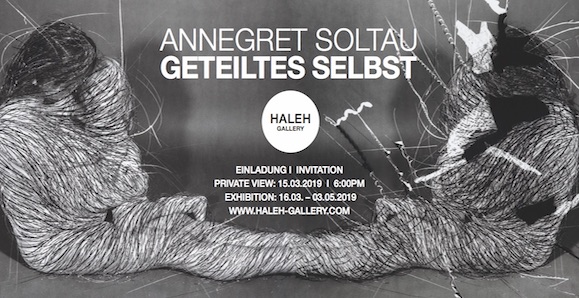GETEILTES SELBST

Haleh Gallery presents with the solo exhibition GETEILTES SELBST a thematic overview of Annegret Soltau’s artistic work. The German artist Annegret Soltau looks back on more than forty years of her artistic career. Soltau is a pioneer of feminist art. With her works, she made a major contribution to the development of performative and experimental arts of the 1970s and 1980s.
Bodily processes play a significant role in Annegret Soltau’s artistic work. Through the integration of the body as basic unit, the artist examines in her works within a feminist theoretical framework questions and concepts of identity of female creativity and reproduction. Soltau does not only document and visualize bodily processes in her works, but these processes turn into an independent artistic means of expression. The artist pursues the objective to create an equivalent connection between body and mind, as Soltau explains: “My most important aim is to include bodily processes in my images and be my own model, because I can go with myself as far as possible.”
The exhibition’s title “Geteiltes Selbst” reflects Soltau’s artistic practice and the staging of her own body. In her works, the artist deconstructs images of her own body while reassembling the fragments forming new configurations. The outcome of this practice is “Geteiltes Selbst” (“Divided Self”). Soltau fragments not only her own image in her works, but she also deconstructs the unity of the subject. Deconstruction as an artistic practice is an important strategy for Soltau to question concepts of female identity and traditional gender roles on a formal and textual level.
Haleh Gallery presents in the exhibition GETEILTES SELBST an overview of Annegret Soltau’s artistic work. Soltau’s artistic expression is manifold and comprises different medias, such as videos and photo etchings. Also on display are following works: Pregnant Series deals with the artist’s personal experiences during her two pregnancies (1978 and 1980), which Soltau captivated in videos and stitching photos while addressing questions of female reproduction and creativity. In her work Mutter-Glück (1977-2001), Soltau creates portraits of her children through processes of deconstruction, fragmentation, and reconstruction to create new grotesque family portraits.
Although contemporary art has virtually no more taboos, the subject of motherhood and children are only rarely addressed. Overcome notions of motherhood and living as a female artist are the reasons why the traditional mother role and artistic career are often considered as incompatible. Annegret Soltau intensively reflects in her artistic works the issues of pregnancy, birth, and motherhood. Soltau’s artistic works is a search of traces to document her individual experiences of pregnancy, birth, and children:
“My pregnancies in 1978 and 1980 became an important theme for me. This personal experience yielded pictures in which I once again used myself as a model, this time myself in the process of being pregnant. The fear that my role as a mother could jeopardize my life as an artist inspired me to create many photos and videos. At this point I was preoccupied with the question of how women combine creativity and motherhood.”
Annegret Soltau (*1946) lives and works in Darmstadt in Germany. She studied from 1967-72 painting and graphic arts at the art universities in Hamburg and Vienna. 1986-87 fellow at Villa Massimo, Rome, 2000 art price oft he city of Darmstadt with the exhibition “Ich selbst”.
Exhibitions (selection):
SCHWANGER, Frieze Masters – Spotlight, One Woman Show, Richard Saltoun Gallery, London UK (2018); SELBST, Maurer Zilioli Contemporary Arts, Munich (2017); DAS KONSTRUKT ICH – das ge-zeichnete Selbst, Galerie Anita Beckers, Frankfurt a.M. (2016);
PULSE MIAMI ART FAIR, Selected works by Annegret Soltau, Miami, USA (Galerie Anita Beckers, Frankfurt) (2013); Mathildenhöhe Darmstadt (2006), Museum of Contemporary Art, Los Angeles (2007), Vancouver Art Gallery (2008-09), Galleria nationale d´arte moderna, Rom (2010), Palazzo Strozzi, Florenz (2012-13).
